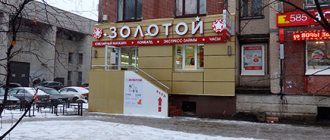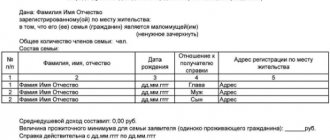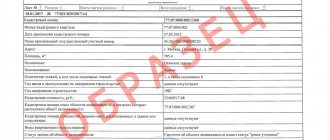The transfer of residential premises to non-residential premises is currently a frequent and understandable procedure. Article 22 of the Housing Code specifies that when transferred to non-residential premises, the apartment must be located on the ground floor or above the non-residential premises. It is also important that the premises have a separate entrance and that no one lives in it or is registered. It is worth noting that after the transfer the entire premises must become completely non-residential, that is, one room cannot be left for permanent residence. The decision on the transfer of housing is made by an interdepartmental commission specially created in each municipality.
We are transferring an apartment to non-residential stock: legal and tax aspects
Macroeconomics Regulation Strategies Management. ATMs, terminals Transfers, pp payments Plastic cards Payment systems. About different things. Banks of Russia Bank rating Revoked licenses. Forum rules All channels read List of participants Mail. Events Organizers Conditions. Search titles only. Transfer of the mortgaged property for residential premises to non-residential premises. Previous 1 2 3 4 Next. Messages Latest activity. Page of 4. All time Today Last week Last month.
Filtering criteria:. At the same time, the non-residential premises are encumbered with a mortgage. Comment Submit Cancel. After all, if the Federal Registration Service is contacted in such cases, it means that permits are also issued for the transfer of housing into non-residential property with a registered mortgage by authorized bodies.
And since municipal authorities have such a practice, we can use the situation as our competitive advantage. Stepanov V. And if it’s relevant, then quote, quote verbatim, please, the Fed’s letter.
A change in the subject of the mortgage during the period of validity of the mortgage agreement does not mean either physical or legal destruction of the subject of pledge, which, within the meaning of subparagraph 3 of paragraph 1 of Article of the Civil Code of the Russian Federation, hereinafter referred to as the Civil Code of the Russian Federation, the Code entails termination of the pledge.
Neither the Code nor the Federal Law “On Real Estate Mortgage” hereinafter referred to as the Mortgage Law require, in order to maintain the validity of the mortgage agreement, changes to it regarding the description of the subject of the mortgage and its valuation, and the registration of these changes. Thus, according to Article 76 of the Law on Mortgage, when providing a loan or a targeted loan for the construction of a residential building, the mortgage agreement may provide for the obligation to be secured by an unfinished object and materials and equipment belonging to the mortgagor that are prepared for construction.
Within the meaning of this article, a mortgage agreement, the subject of which was a residential building under construction, without making any changes and additions to it in terms of the description of the subject of the mortgage and its assessment and without registering such changes and additions, extends to the constructed residential building. Our position is confirmed by the Information Letter HAS RF ANSWER: We believe that the current legislation has not resolved the issue of liquidation and transformation of an object in relation to the above situation.
Legal grounds to stop recording the mortgage of an apartment, in accordance with Art. However, in paragraph. In connection with this, we believe that if there is the consent of the mortgagee to reconstruct the residential premises during the state registration of rights to non-residential premises, it is possible to transfer records of the mortgage to the newly formed property; in this case, the subject will be changed in the Unified State Register collateral: the apartment will change to non-residential premises, but the amounts and the term of the obligation secured by the mortgage will remain the same.
Sasha St. This is the response of the Federal Registration Service signed by the head. Hello, fellow forum residents! Dear colleagues, help resolve the dispute. The bank accepted a residential premises as collateral; this is not a collateral by force of law. The mortgagor from the bank converted this premises into non-residential premises and went to the Registration Chamber to register the changes. The Registration Chamber writes a letter to the bank asking for permission to terminate the ownership of the residential premises that are pledged. The bank is angry, furious, quarreling with the borrower, but since there is no point in revoking the loan ahead of schedule, the borrower will not return such an amount immediately, and since it is doubtful to go to court and oblige the mortgagor to redo everything back or collect losses from him in general, the bank resolves the problem like this: Concludes with the mortgagor agrees to replace the subject of pledge from residential to non-residential for the period until the rights to non-residential are registered, gives consent to the termination of the right to residential, and then they enter into a pledge agreement for non-residential.
Everything seemed to be top-notch, the mortgagor signed everything, the registry office deleted the record about the residential premises as such or about the rights to it, having previously, as I understand it, based on our letter of consent, removed the encumbrance - the pledge.
We go with a new contract for non-residential premises to the registry office and HERE is the trick - they refuse to accept it due to the fact that the pledge is also ours! Bank - how so? But the Registration Chamber claims that the pledge in this case does not stop, but continues. In addition, I consider any references to the rights of maintaining a register not entirely appropriate; the legal provisions on pledge are not regulated by them. By the way, the registry office writes this in its letter to the bank: “In connection with the termination of ownership of such and such an object, I am deliberately leaving the topic of the legality of the transfer, but I feel I will have to repeat myself.
Let's say the translation is illegal, what next? The bank is not interested in recognizing this transfer as invalid, it is not interested in withdrawing the loan ahead of schedule, it is not interested in collecting losses that actually do not yet exist, etc. It is in the interests of the bank to take a new non-residential premises as collateral and calm down, especially since in this form it is more expensive. Well, does anyone know the standards for “Transition”? I am of the opinion that the pledge terminates along with the termination of the right.
I read about a precedent where the pledge was preserved when the category of land was changed. But the mortgage cannot “roll over.” Due to state registration. If it weren't for her, everything would be great. At least from the fact that you get the encumbrance before the object arose. In general, when understanding the nature of a mortgage, the analogy with registering a marriage is best suited. You can cohabit in any way you like, but if there is no stamp, then it is not a mortgage.
And the Fed can do anything. By the way, her liability is insured. You meant the pledge. I had a case that when dividing tender. I fundamentally disagree with you. Firstly, it talks about unfinished buildings, secondly, residential premises, and thirdly, which are mortgaged by virtue of the Law. Don't you see?! This is not considered there at all. Yes, we actually resolved the situation. It was possible, of course, to change the already ineffective right of the terminated pledge agreement, by which a subsequent pledge would not be allowed, etc.
That's not the point. For me, this was a fundamental issue - the basis for transferring the record of the encumbrance and preserving the collateral. I think reg.
I was interested in the opinion of the forum, maybe someone knew these reasons, unlike me. It turns out no one knows. Why no one, I have already said: when the purpose of the premises changes, residential or non-residential, or vice versa, the object itself does not legally or actually cease, and since the right to it does not cease, its mortgage is preserved. Petya The right to non-residential premises ceases and the right to non-residential premises arises. Help Feedback Up.
Not really. OK Cancel.
Algorithm of actions
The entire translation process can be divided into five stages. If the purpose of the apartment changes, several additional stages are added. In the case of a mansion, some of the steps can be skipped.
Holding a general meeting
The meetings are authorized to make decisions if there is a quorum - a minimum sufficient number of participants. If there is one entrance to the apartment building, the presence of owners with at least ⅔ of the total number of votes is required. If there are several entrances, a quorum is assembled if there are co-owners with 50% of the votes. But this 50% must necessarily include the owners from the entrance where the transferred object is located, who own at least ⅔ of all votes.
In this case, votes are counted not based on the number of voters, but on the area of their property. Not only the planned redevelopment is brought up for discussion, but also the future purpose of the property. In any case, to move on, we need a positive verdict from the co-owners. The decision is considered adopted if the majority of participants vote for it (including the majority in the sector where the transfer is taking place).
Based on the voting results, a protocol is drawn up. It is better to prepare several copies at once, one for the administration, the second for the management company.
Consent of neighbors
The owners of adjacent apartments give separate consent. The absence of objections from nearby neighbors is an imperative requirement. Adjacent premises are those that have a common wall with the object being translated, and are also located directly above or below it.
Ensuring compliance with established parameters
The applicant is obliged to ensure compliance with fire safety rules at the new retail outlet or coffee shop, install proper sound insulation and ventilation,, if necessary, organize a goods loading area, etc. Particular attention must be paid to the construction of a separate entrance. If this requires refurbishment of the façade, you will have to ask for approval from all owner-occupiers.
Submission of documents
Once permits are received, the application and applications are submitted to the City. In some regions there are city property departments or other specialized departments. You can also send an appeal through the MFC.
Question:
How long will it take for my application to be reviewed?
Answer:
According to paragraph 4 of Art. 23 of the Housing Code, officials are required to make a decision no later than 45 days from the date of application. The refusal can be appealed in court.
Registering changes
After approval from the municipality, a new technical plan must be prepared. The document is ordered from a cadastral engineer. The plan is executed in electronic format and certified by the electronic signature of the performer. The technical documentation is sent to Rosreestr, where the assignment of non-residential status is registered within 15 days.
Experts named several original ways to lose a mortgaged apartment
Question: Is it possible to buy an apartment with a mortgage and then transfer it to non-residential use? Answer An apartment purchased with a mortgage can be transferred to a non-residential property, but only with the consent of the creditor bank. You should apply for a loan to purchase a residential apartment and immediately after registering the transaction, apply for its transfer to a non-residential fund. As a rule, banks do not interfere with this operation. However, the transfer of an apartment in an apartment building to a non-residential premises is permitted by Article 0 of the Housing Code only in cases where such an apartment is located on the first floor of the specified building. Or above the first floor, but the premises located directly below the apartment being converted into non-residential premises are not residential.
Nowadays, it has become much easier to transfer residential premises to non-residential ones by purchasing an apartment with a mortgage and transferring it to non-residential premises.
Reasons for changing the purpose
In practice, there are various reasons why they want to turn a mansion into a non-residential building. But most often this is needed either to organize a business, or to conduct agriculture or develop a local area. For example, an old building in which no one has lived for a long time can be given over to a store, converted into a barn, a bathhouse, an office or a spa. It all depends on the location of the building and the capabilities of the owner or tenant.
Moreover, if the owner converted the old house into a barn and started a small farm for his own needs, this does not imply any additional expenses. However, if such property is used in commercial activities, you will have to pay income taxes.
Important! According to paragraph 2 of Art. 17 of the Housing Code of the Russian Federation, a citizen has the right to use his home for professional work or entrepreneurship, if this does not affect the rights and interests of his neighbors.
Is it possible to convert an apartment with a mortgage into a non-residential property and create a hairdresser there?
Now it has become much more difficult to convert residential premises into non-residential ones, even if the property is owned. The tightening of the regulations was made to protect residents, since previously many forged the signatures of neighbors or even bribed government services to obtain permission. In new buildings, things are better: here a certain percentage of premises on the first floors are usually allocated, intended for commercial purposes and already equipped with separate entrances, canopies, etc. If the loan for the property has not yet been paid, then it is in principle impossible to convert it into non-residential - usually in a mortgage The contract contains a provision prohibiting changing the purpose of the object and even making redevelopments. By violating these conditions and not notifying the bank about it, the borrower is at great risk - the bank's collateral services may come with an inspection, and then fines will follow, a requirement for early repayment of the loan or the return of the property to its original condition. The bank rarely gives the go-ahead for such actions, since the object in this case may lose its liquidity. After all, the bank is, first of all, interested in its quick implementation and reimbursement of the loan amount.
Is it possible to transfer an apartment purchased with a mortgage to non-residential stock?
Owners of apartments purchased with a mortgage often want to immediately begin redevelopment and repairs, however, as experts interviewed by RIA Novosti assure, doing this is dangerous - you can simply lose your home. As Valery Barinets, general director of the real estate agency A-Realty Group, noted, you can only do one thing with a mortgaged apartment - use it for its intended purpose, that is, actually live. At the same time, according to experts interviewed by RIA Novosti, unauthorized actions with a mortgaged apartment can result in the most unpleasant consequences for its owner, including the loss of the mortgaged home. Meanwhile, the hardest thing is to agree with the bank on the redevelopment of an apartment that is pledged, Barinets pointed out. He explained that, firstly, with illegal redevelopment it is almost impossible to purchase an apartment. Olga Dokuchaeva, Deputy Head of the Department of Retail Credit Products, Department of Marketing and Banking Products of Rosbank, also agrees with him.
On the one hand, it is possible to transfer an apartment purchased with a mortgage to a non-residential fund only with the consent of the creditor bank, on the other hand - c.
Determination of living space
According to Art. 15 Residential complex housing is isolated real estate that can be used for permanent residence. Such premises must meet special sanitary and technical requirements, for example, be equipped with engineering systems for electric lighting, water supply and drainage, heating and ventilation.
From the point of view of the legislator, you can live in residential buildings, apartments, their separate parts, as well as in separate rooms. At the same time, it is prohibited to use living space for organizing industrial production or for providing hotel services.








